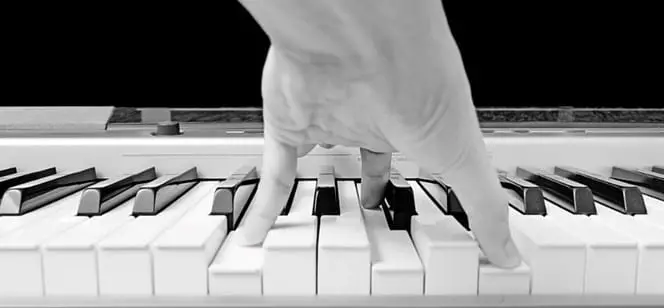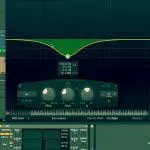Minor chords are the first types of piano chords that a player learns as a student or piano student. Minor chords are very basic and the easiest to learn. When you’re learning how to play the piano, you must start with the major chords and proceed with the minor chords.
Minor chords are known as triads because this has three notes, the root, minor third, and perfect fifth note. The chord A minor has a root note A, the minor third C, and perfect fifth E.
The minor 3rd is 3 half-steps over the root note, and the perfect 5th is seven steps below the root note or 4 half-steps over the minor 3rd.
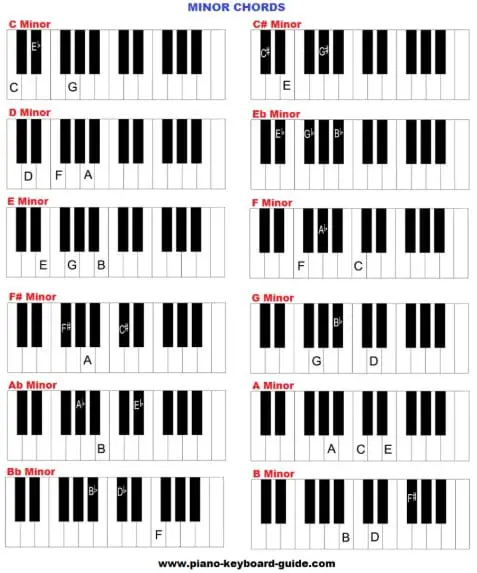
Building minor chords using semitones
To build a minor chord with the use of semitones, begin with the root note or the note from where the chord derives its name. Move three semitones forward than the root for your second note. For the third note, move seven semitones forward from the root note.
A formula has been created for this, and it’s R + 3 HS + 4 HS with HS as half-steps.
When reading minor chords, you’ll find the symbols -, m or min, such as Em, Emin, and E- are all the same minor chords, but it is less common to use E-. Another word to describe a minor triad is a minor triad interval with the major 3rd interval on the top. The chord Am, the interval from A-C, C is a minor 3rd interval; however, the interval from chords C – E is a major 3rd interval.
As mentioned, the major chords are learned first, and if you have perfected these chords, it is already going to be easy to learn to play minor chords. All you need to do is to move the middle note a semitone lower.
To change the C major to a minor chord, rather than playing the chords C, E, G, play the note one semitone lower from E. Use the black key to the left of E, which is the note E flat. This is now the C minor chord.
Here are the minor chords from all the twelve keys. Take note that the chords and notes that create that chord from the root are followed by the minor 3rd and perfect 5th.
| C minor | C-Eb-G |
| C sharp minor | C#-E-G# |
| D flat minor | Db-Fb (E) – Ab |
| D minor | D-F-A |
| D sharp minor | D#-F#-A# |
| E flat minor | Eb-Gb-Bb |
| E minor | E-G-B |
| F minor | F-Ab-C |
| F sharp minor | F#-A-C# |
| G flat minor | Gb-Bbb (A)-Db |
| G minor | G-Bb-D |
| G sharp minor | G#-B-D# |
| A flat minor | Ab-Cb (B) – Eb |
| A minor | A-C-E |
| A sharp minor | A#-C#-E# |
| B flat minor | Bb-Db-F |
| B minor | B-D-F# |
You might find some notes or chords with different names, but when you play these on the piano, you will use the same keys. This method is called enharmonic. Using this method, C# is enharmonic of Db, while F# is enharmonic of Gb. Those who play piano claim that minor chords create that depressed mood in a song, but major chords tend to liven things up.
Using root positioning and inversions
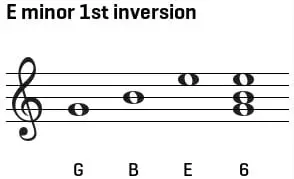
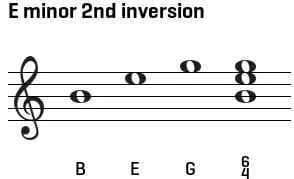
Instead of looking at the notes in the root position, we will now learn how to look at notes in the inverse position. In the root position, you begin with the root and then the minor 3rd and the perfect 5th. For instance, E minor in the root position is E-G-B or 1-3-5. There are two inversions of this minor chord.
The first inversion, the notes, is 3-5-1. For E min chord, the first is in G, B, and E. The note E is an octave higher, and thus you’ll get G-B-E. The second inversion is 5-1-3, and using E min; the notes will be B-E-G.
Recognizing all minor chords
Three of the twelve minor chords follow a pattern: a white key, a black key, and a white key. These chords are the C min, G min, and F min. The second three are composed of only white keys, and these are the D min, A min, and E min. The third set has a pattern that goes black key, white key, and black key, and these are Db min, Ab min, and Gb min.
Meanwhile, the 4th set is unique with the Eb only composed of black keys. The Bb min is composed of a black key, black key, and a white key. B min has a white key, white key, and a black key.
C minor Chord
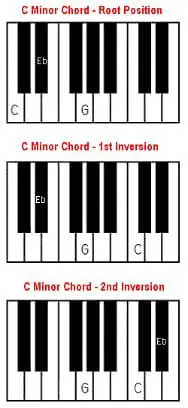
The C min chord or C m triad is created by combining notes C, Eb, and G. These notes are the root note, the flat 3rd, and the perfect 5th of the CM scale. You may also form the C min if you know the note placement on a C major chord. Just bring down the middle note or the E in the chord by a half step or a semitone. Therefore instead of C-E-G, you will play C-Eb-G. The C minor chord is written as Cm, but C min and the C- symbols may also be used.
Similar to all the minor chords, the Cm has a depressing or sad sound, but its major chord counterparts have a happier tune.
The C min is composed of a minor 3Rd and a major 3rd. To make a minor 3rd, you use a one, and a halftone and a major 3rd have 2 tones. The distance between the notes C and Eb is 1 ½ tone or three halftones.
The space between Eb and G is composed of 2 tones, 4 halftones. Eb is 3 keys from C while G is 4 keys from Eb.
After learning the C min chord in root position, let’s learn the two inversions. The first inversion has the notes in Eb-G-C with C an octave above than C in the root location. The first inversion has the notes G-C-Eb where Eb is an octave above Eb in the root location. C is an octave above, while G stays in the same root location in both inversions.
Fingerings of the Cm chord
From the root position, C-Eb and G (fingers 1-3-5, respectively). In the first inversion Eb-G-C (fingers 1-2-5 respectively and in the second inversion, G-C-Eb (fingers 1-3-4, respectively).
D min Chord
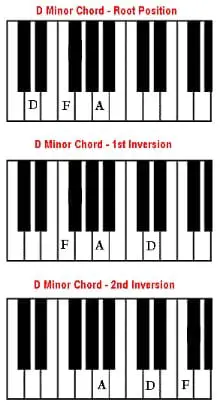
To create the D min chord, use D as the root note, F as the minor 3rd, and F as the perfect 5th in A of the major chord. The minor 3rd is the flat third. To play D F# A, this is D major. Rather than F#, reduce the note by a semitone to create F natural.
Dm chord has F as one and a half-tones or 3 semitones higher compared to D. A is 2 tones or 4 semitones higher compared to F. The D min chord is composed of a minor 3rd and a major 3rd. D to F is a minor 3rd interval whereas in the middle of F, and A is a major 3rd interval.
Compared to the D major chord, the D min has a melancholic sound.
The root location of a D min chord is D-F-A. The D min chord is also played in two inversions. The first one starts with F-A-D with the last note D an octave above than D in the root location. The F stays in position. The second inversion has A-D-F. A stays in the same position while D and F are an octave above the keyboard.
Fingerings of the D min chord
To play the D min chord following the finger positions. The root is D-F-A (fingers 1-3-5, respectively), first inversion F-A-D (fingers 1-2-4respectively), and second inversion A-D-F (fingers 1-3-5, respectively).
E minor Chord
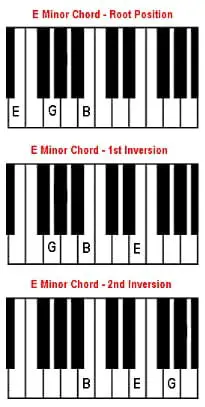
The E min uses only white keys. Combine the root, flat 3rd, and perfect 5th of the E major. These are E-G-B, and the E minor chord is represented by E min and E-. The note has a sad sound, whereas its major counterpart has a livelier mood.
For the Em chord, combine a minor 3rd and a major 3rd. The distance from E and G is 1 ½ tone or the minor 3rd. Meanwhile, the distance of G and B is 2 tones or major 3rd.
The two inversions of the Em chord is played differently from the root E-G-B. The first inversion is G-B-E, while the second inversion is B-E-G.
Fingerings of the E min chord
Play the Em in root location using the right hand in E-G-B (fingers 1-3-5, respectively). The first inversion is played G-B-E (fingers 1-2-5, respectively), and the second inversion is B-E-G (fingers 1-3-5, respectively).
F min Chord
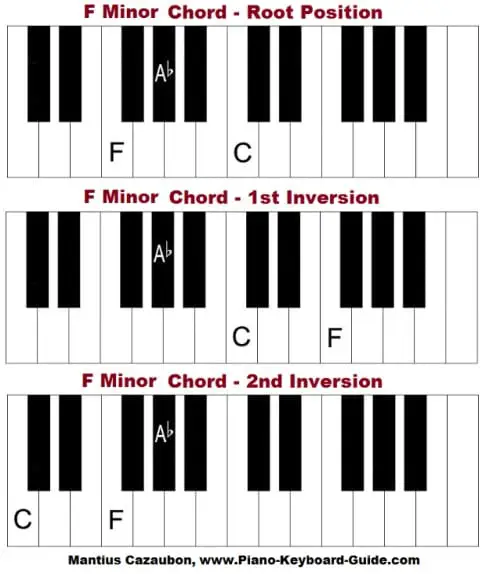
For the F major chord, the notes are F-G-A-Bb-C-D-E. A is a major 3rd. For the F min chord, the 3rd note is played a half step or a semitone lower. Instead of note A, play Ab. The min chord is F-Ab- C with F as root, Ab is the flat 3rd, and C is the perfect 5th. If you are familiar with the F major scale, just reduce the middle note by a ½ step. You can write the F minor chord as Fm, F min, or F-. Using the F, followed by a minus sign, is not commonly used.
Similar to other minor chords, the F min has a minor 3rd and a major 3rd interval. Between F and Ab is a minor 3rd, while between Ab and C is a major 3rd interval. A minor 3rd is 3 half-steps above, while a major 3rd is four half-steps above a note. Ab is three keys from F going to the right, while C is four keys from the right of Ab.
Fingerings of the F min chord
From the root position F-Ab-C (fingers 1-3-5, respectively). In the first inversion Ab-C-F (fingers 1-2-5, respectively) and the second inversion C-F-Ab (fingers 1-3-4, respectively).
G min Chord
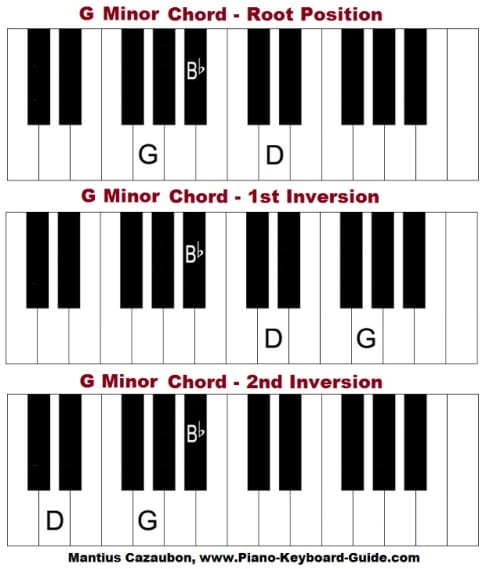
From the G major scale, G-A-B-C-D-E-F#-G. To build the G min chord, reduce note 3, which is B a half-step. Instead of B, play it B flat. The notes for G min are G-Bb-D compared to G major G-B-D. The G minor chord is written as G min, Gm, or G- but the last one is less commonly used.
G minor is a combination of a minor 3rd and a major 3rd. From G to Bb is a minor 3rd interval, and from Bb to D is the major interval. D is four keys from the right of Bb, and these are 4 semitones.
In root location, G minor chord is G-Bb-D. The first inversion is Bb-D-G with Bb as the lowest note, D in the middle, and G is an octave above. The second inversion is D-G-Bb with D as the lowest note, G the middle and Bb as the highest.
Fingerings of the G min chord
Fingerings of the G minor chord start with the root at G-Bb-D (fingers 1-3-5, respectively). The first inversion is Bb-D-G (fingers 1-2-5) and second inversion as D-G-Bb (fingers 1-3-4, respectively).
A min Chord
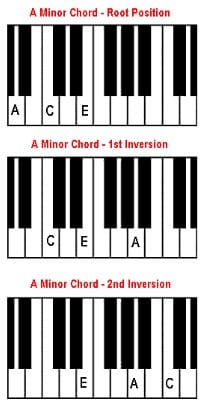
A minor chord is played mostly by white keys and is formed by notes A-C-E. A is the root, C is the minor 3rd and E as the perfect 5th. C is 1 ½ tone above A, and E is two tones above C. In between A and C is a halftone or three semitones and is the first interval. In between C and E are two semitones and is the second interval. To write the A minor chord, use Am, A min or A- but the latter is not very common.
Fingerings of the A min chord and inversions
The root is A-C-E and is played by fingers 1-3-5. The first inversion is C-E-A played by fingers 1-2-5, respectively, while the second inversion is E-A-C played by fingers 1-3-5.
B min Chord
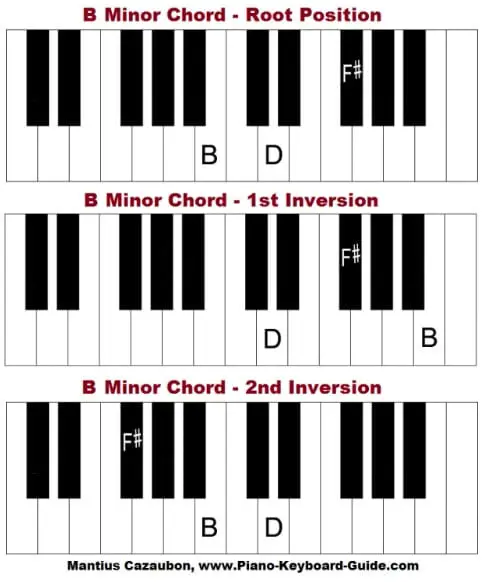
From the B major scale, the notes are B–C#–D#–E–F#–G#–A#–B. B is the root, C# the major 2nd, D# is the major 3rd, etc. To create the B min, the 3rd note is D# and is a semitone lower. Rather than D#, use D. And D# is the major 3rd, and D is the minor 3rd. The notes of the B min chord is B-D-F#.
Writing the B min is using Bm, B min, or B- but B with a minus sign is seldom used. In the root position, B-D-F# and the first inversion is D-F#-B while the second inversion is F#-B-D.
Fingerings of the B min chord
To play in root position, B-D-F# (fingers 1-2-4, respectively). For the first inversion, D-F#-B (fingers 1-3-5, respectively) and second inversion at F#-B-D (fingers 1-3-5, respectively).

